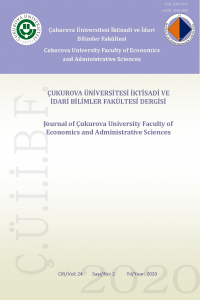Cash Flow Sensitivity Analysis of Energy Companies
Anahtar Kelimeler:
Energy Investments, Investment, Investment Cash Flow Sensitivity, Financial Constraint
Cash Flow Sensitivity Analysis of Energy Companies
If financial markets are efficient, companies can easily access finance. However, due to market frictions in financial markets, it is often not easy to find suitable financing sources for investments. As a result of the market frictions, the growth of national economies slows down. In this study, this problem will be addressed for energy companies. In other words, we examine whether energy companies are faced with financial constraints using the data of energy companies in 13 selected countries between the years 2010-2021. The results show that cash flows created by energy companies in 7 countries are effective in financing their investments. High cash flows and increased investments resulting from fluctuations in energy prices may also indicate that companies exhibit excessive investment behavior due to agency problems. On the other hand, all stakeholders need to make timely investments in the energy sector compared to other industries to support energy policies and increase social welfare.
___
- Almeida, H., Campello, M., & Weisbach, M. S. (2004). The Cash Flow Sensitivity of Cash. Journal of Finance 59:1777–804.
- Alti, A. (2003). How Sensitive Is Investment to Cash Flow When Financing Is Frictionless? Journal of Finance 58:707–22.
- Ağca, Ş., & Mozumdar, A. (2008). The impact of capital market imperfections on investment–cash flow sensitivity. Journal of Banking & Finance, 32(2), 207- 216.
- Bond, S. R., & Söderbom, M. (2013). Conditional investment–cash flow sensitivities and financing constraints. Journal of the European Economic Association, 11(1), 112-136.
- Cameron, A. C., & Trivedi, P. K. (2005). Microeconometrics: methods and applications. Cambridge university press.
- Erickson, T., & T. M. Whited. (2000). Measurement Error and the Relationship between Investment and Q. Journal of Political Economy 108:1027–57.
- Fazzari, S., Hubbard, R. G., & Petersen, B. (1988). Investment, financing decisions, and tax policy. The American economic review, 78(2), 200-205.
- Greene, W. (2012) Econometric Analysis. 7th Edition, Prentice Hall, Upper Saddle River.
- Gujarati, D. C. P. (2003). Basic Econometrics by Damodar N.
- Hadlock, C. J., & Pierce, J. R. (2010). New evidence on measuring financial constraints: Moving beyond the KZ index. The Review of Financial Studies, 23(5), 1909- 1940.
- Islam, S. S., & Mozumdar, A. (2007). Financial market development and the importance of internal cash: Evidence from international data. Journal of Banking & Finance, 31(3), 641-658.
- Kaplan, S. N., & Zingales, L. (1997). Do investment-cash flow sensitivities provide useful measures of financing constraints?. The quarterly journal of economics, 112(1), 169-215.
- Modigliani, F., & Miller, M. H. (1958). The cost of capital, corporation finance and the theory of investment. The American economic review, 48(3), 261-297.
- Moyen, N. (2004). Investment–cash flow sensitivities: Constrained versus unconstrained firms. The Journal of finance, 59(5), 2061-2092.
- Pál, R., & Kozhan, R. (2009). Firms' investment under financial constraints: a euro area investigation. Applied financial economics, 19(20), 1611-1624.
- Pawlina, G., & Renneboog, L. (2005). Is investment‐cash flow sensitivity caused by agency costs or asymmetric information? Evidence from the UK. European Financial Management, 11(4), 483-513.
- Pindado, J., Requejo, I., & de la Torre, C. (2011). Family control and investment–cash flow sensitivity: Empirical evidence from the Euro zone. Journal of Corporate Finance, 17(5), 1389-1409.
- Roodman, D. (2009). How to do xtabond2: An introduction to difference and system GMM in Stata. The stata journal, 9(1), 86-136.
- Tatoğlu, F. Y. (2018). Panel Veri Ekonometrisi. İstanbul: Beta Basım Yayım Dağıtım 2012, pp.334.
- ISSN: 1300-3747
- Başlangıç: 1987
- Yayıncı: Çukurova Üniversitesi
Sayıdaki Diğer Makaleler
Cash Flow Sensitivity Analysis of Energy Companies
Emin Hüseyin ÇETENAK, Özkan HAYKIR, Özlem ÖZTÜRK ÇETENAK, Melikşah AYDIN
Murat BAYRAKTAR, Neşe ALGAN, Harun BAL, Başak Gül AKAR, Esma ERDOĞAN
Sermaye Piyasası Araçları ile Kalkınma ve Yatırım Bankalarının Performansları Üzerine Bir İncele
